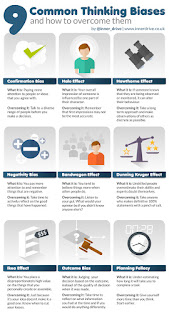http://www.innerdrive.co.uk/Release_Your_Inner_Drive/9-common-thinking-biases/
9 Common Thinking Biases
Our thought processes are not always the clearest. They are not always the most rational. Psychologists have identified over 100 of these thinking biases. This blog looks at just nine of these, which seem particularly relevant to the world of both education and sport, and offers tips on how best to overcome them.
Confirmation Bias – this refers to the idea that people pay more attention to people or ideas that they had previously agreed with. A great example of this is illustrated in Daniel T. Willingham's excellent book, 'When Can You Trust The Experts'. He details a fascinating study in which half a class of students were told that their supply teacher was 'rather cold, industrious, critical, practical and determined'. The other half were told the exact same sentence, except the words 'rather cold' were replaced with 'very warm'.
Students who had expected to be taught by a warm teacher rated the supply teacher as nicer and funnier. In other words, what they saw and interpreted backed up their previous belief.
This short video clip of Derren Brown gives an example of the halo effect in action, in social situations:
Their subsequent study found that those who score in the lower bracket for their ability to tell funny jokes, use of grammar and ability to think logically consistently rated themselves in a much higher category.
Think none of these biases apply to you? Chances are you are suffering from the Bias Blind Spot, which refers to the belief that other people are more likely to have these biases. The good news is you now know what some of the most common biases are and how to overcome them.
Confirmation Bias – this refers to the idea that people pay more attention to people or ideas that they had previously agreed with. A great example of this is illustrated in Daniel T. Willingham's excellent book, 'When Can You Trust The Experts'. He details a fascinating study in which half a class of students were told that their supply teacher was 'rather cold, industrious, critical, practical and determined'. The other half were told the exact same sentence, except the words 'rather cold' were replaced with 'very warm'.
Students who had expected to be taught by a warm teacher rated the supply teacher as nicer and funnier. In other words, what they saw and interpreted backed up their previous belief.
- How to Overcome This? Have a diverse range of people to talk to. This range of personalities can help avoid group-think and help minimise confirmation bias.
This short video clip of Derren Brown gives an example of the halo effect in action, in social situations:
- How to Overcome This? Remember that first impressions may not be the most accurate. Try not to have too fixed an opinion too early on and see things not just as black or white, awful or amazing, successful or unsuccessful.
- How to overcome it? Take a long term approach. One off observations are probably fairly useless. Where possible, make these as discrete and subtle as possible, to minimise the impact of your presence there.
- How to Overcome This? Take time to actively search out and reflect on the good things that have happened. It is unlikely that everything is all bad. You can read more about challenging these sort of unhelpful thoughts in this blog here.
- How to Overcome This? If in doubt, try listening to your gut. If you are not sure if you are being swayed by the crowd, ask yourself 'what would your opinion be if you didn't know anyone else's?'
Their subsequent study found that those who score in the lower bracket for their ability to tell funny jokes, use of grammar and ability to think logically consistently rated themselves in a much higher category.
- How to Overcome This? Take anyone who makes definitive 100% statements with a pinch of salt. Experts are often comfortable talking about what they don't know or the limitations of their work.
- How to Overcome This? Just because it's your idea doesn't make it a good one. Know when to cut your losses and move on.
- How to Overcome This? Take time to reflect on what information you had at the time and if you would do anything differently next time.
- How to Overcome This? Give yourself more time than you think. Start earlier.
Think none of these biases apply to you? Chances are you are suffering from the Bias Blind Spot, which refers to the belief that other people are more likely to have these biases. The good news is you now know what some of the most common biases are and how to overcome them.

No comments:
Post a Comment